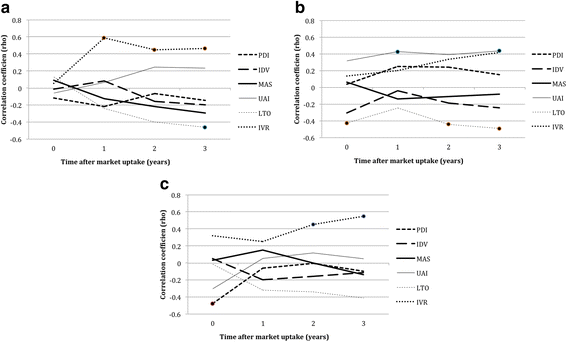Variability in market uptake of psychotropic medications in Europe reflects cultural diversity
- PMID: 29110651
- PMCID: PMC5674841
- DOI: 10.1186/s12913-017-2649-6
Variability in market uptake of psychotropic medications in Europe reflects cultural diversity
Abstract
Background: In the last 20-30 years, many international studies have found substantial differences in the use of (older) psychotropic medication between European countries. The majority mentioned an important role for attitudes and beliefs towards psychotropic medication. So far, no studies have looked into the effects of cultural diversity on the use of new medications entering the market. As national cultures relate deeply to held values regarding, for example, what is seen as effective versus ineffective or safe versus dangerous, (cultural) diversity in decision making around the role of new medications in clinical practice may already be expected from the first day after market authorization.
Methods: This study examined the relation between cultural diversity, described in Hofstede's model of cultural dimensions (Power Distance, Individualism, Masculinity, Uncertainty Avoidance, Indulgence and Long-Term Orientation) and utilization of three new psychotropic medications, namely aripiprazole, duloxetine and pregabalin in Europe. Country level sales data of the case study medications were correlated to country-specific scores of Hofstede's cultural dimensions. IMS Health's MIDAS database has been used for sales data (converted to Defined Daily Doses/1000 inhabitants/day) for the case study medications from the market authorization date in 2004 until December 2009 for 23 EU member states.
Results: Consumption of the case study medications was seen in all countries. In general, pregabalin was used more often than aripiprazole and duloxetine. In 2 years after market authorization, approximately 80% of all countries have reported use of all three molecules. Correlations between Hofstede dimensions individualism, long-term orientation and indulgence and total use of the case study medications tended to become stronger over time, but they were only statistically significant for indulgence at two years after market authorization (rho = 0.51, p = 0.014) and three years after market authorization (rho = 0.54, p = 0.008). A more detailed analysis showed (slight) variation by molecule.
Conclusions: This study is a first step in including cultural dimensions when explaining cross-national variation in the use of new medications. The results indicate that indulgence, however marginally, is a cultural aspect that relates to the utilization of new psychotropic medications, suggesting that within the cultural context, less regulation of social norms is a main factor in explaining cross-national variation in uptake of these medications.
Keywords: Cultural diversity; European Union; Hofstede dimensions; Psychotropic medications; Utilization; Variation.
Conflict of interest statement
Ethics approval and consent to participate
According to Dutch law, ethics approval was not applicable and consent to participate was not required because the study does not subject persons to treatment or require persons to follow a certain behavioral strategy nor involves handling of patient data (Medical Research (Human Subjects) Act). We have added this to the method section.
Consent for publication
Not applicable.
Competing interests
None declared. The department of Pharmacoepidemiology and Clinical Pharmacology, Utrecht Institute for Pharmaceutical Sciences, has received unrestricted research funding from the Netherlands Organisation for Health Research and Development (ZonMW), the National Health Care Insurance Board (ZiN), the Royal Dutch Pharmacists Association (KNMP), the private-public funded Top Institute Pharma (
Publisher’s Note
Springer Nature remains neutral with regard to jurisdictional claims in published maps and institutional affiliations.
Figures


References
-
- Jervis N. What is a culture? World Communities, The State Education Department.New York: The University of the State of New York. 2006.
-
- Payer L. Medicine and culture: varieties of treatment in the United States, England, West Germany and France. First ed. New York: Henry Holt and Compane, LLC; 1996.
MeSH terms
Substances
LinkOut - more resources
Full Text Sources
Other Literature Sources
Research Materials

